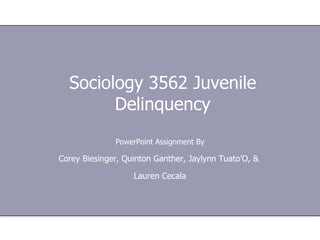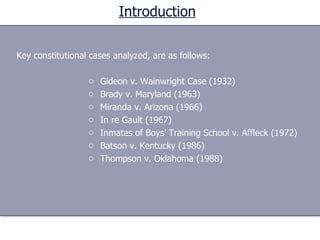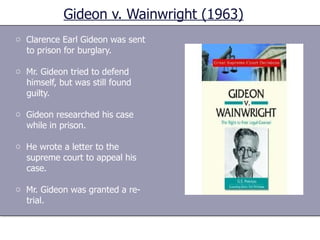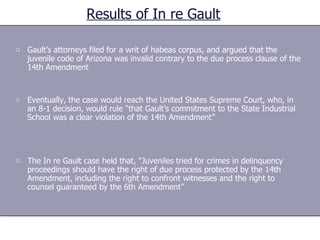Jd group presentation 07-26-11
- 1. Sociology 3562 Juvenile Delinquency PowerPoint Assignment By Corey Biesinger, Quinton Ganther, Jaylynn Tuato¡¯O, & Lauren Cecala
- 2. Introduction Key constitutional cases analyzed, are as follows: Gideon v. Wainwright Case (1932) Brady v. Maryland (1963) Miranda v. Arizona (1966) In re Gault (1967) Inmates of Boys¡¯ Training School v. Affleck (1972) Batson v. Kentucky (1986) Thompson v. Oklahoma (1988)
- 3. Gideon v. Wainwright (1963) All criminal defendants in the US have a right to counsel. All states must provide legal counsel to those who cannot afford counsel. Public defenders are assigned to defendants who cannot afford legal counsel.
- 4. Gideon v. Wainwright (1963) Clarence Earl Gideon was sent to prison for burglary. Mr. Gideon tried to defend himself, but was still found guilty. Gideon researched his case while in prison. He wrote a letter to the supreme court to appeal his case. Mr. Gideon was granted a re- trial.
- 5. Brady v. Maryland (1963) Maryland prosecuted Brady and a companion, Boblit for murder. Brady admitted being involved in the murder, but claimed Boblit had done the actual killing. The prosecution had withheld a written statement by Boblit confessing that he had performed the act of killing by himself. Brady challenged his conviction, arguing that it had been contrary to the Due Process Clause of the 14 th Amendment to the United States Constitution.
- 6. Results of the Brady v. Maryland Case ¡° The Supreme Court declared that regardless of the good faith or bad faith of the prosecution, the suppression of evidence favorable to the accused violates due process where the evidence is material to either guilt or punishment.¡± The government has a legally affirmative duty to reveal justifiable evidence to the defendant to help protect and assure the defendant's right to a fair trial under the Fifth and Fourteenth Amendment's Due Process Clauses.
- 7. Miranda v. Arizona (1966) Ernesto Arturo Miranda was arrested and taken to the police station where officers questioned him for two hours. He signed a confession which stated that it was made voluntarily and that he had full knowledge of his legal rights. His confession was used against him at trial and over his objection. Miranda was convicted of rape and kidnapping. The state Supreme Court affirmed the conviction. Miranda appealed his conviction on the grounds that prior to confessing, he had not been informed of his Fifth Amendment right against self incrimination or his Sixth Amendment right to counsel.
- 8. Results of the Miranda v. Arizona Case Lawyers can be present during all stages of arrest, including interrogation. Established new rules for the treatment of criminals. Defendants arrested under state law must be informed of their constitutional rights against self-incrimination and to representation by an attorney before being interrogated when in police custody.
- 9. In re Gault (1967) At age 15, Gerald Gault was taken into custody on suspicion of making a lewd phone call to his neighbor, Mrs.. Ora Cook. Gault was currently on probation for stealing a wallet. His parents were not informed of Gerald being taken into custody. Gault was taken to the county Children¡¯s Detention Home, where his mother eventually located him, but was not permitted to take him home. The next day a preliminary hearing took place, Mrs. Cook was absent at the trial. After being questioned, Gault would remain in custody for several days until being released. Judge Mcghee ended the hearing by saying he would ¡°think about it¡± (Gault¡¯s punishment).
- 10. In re Gault (1967) continued¡ At Gault¡¯s release, a letter was sent informing Gault that ¡°Judge McGHEE has set Monday June 15, 1964 at 11:00 A.M.¡± for his next hearing Mrs. Cook again was not present at the hearing. There was no transcript or recording at either hearing. Gault was never ¡°advised of any right to remain silent, right to be represented by counsel, or any other constitutional rights.¡± Hence, Gault was committed as a juvenile delinquent to the State Industrial School until he was 21 years old, unless sooner discharged
- 11. Results of In re Gault Gault¡¯s attorneys filed for a writ of habeas corpus, and argued that the juvenile code of Arizona was invalid contrary to the due process clause of the 14th Amendment Eventually, the case would reach the United States Supreme Court, who, in an 8-1 decision, would rule ¡°that Gault¡¯s commitment to the State Industrial School was a clear violation of the 14th Amendment¡± The In re Gault case held that, "Juveniles tried for crimes in delinquency proceedings should have the right of due process protected by the 14th Amendment, including the right to confront witnesses and the right to counsel guaranteed by the 6th Amendment¡±
- 12. Inmates of Boys¡¯ Training School v Affleck (1972) Five juvenile inmates filed suit in the United States District Court against the Rhode Island Boys¡¯ Training School The conditions at the school were challenged indicating various practices violated due process rights. The reforms ordered by the Court pertained to ¡°solitary confinement, minimal conditions of confinement, rehabilitative treatment, vocational training, psychiatric counseling and drug rehabilitation¡±
- 13. Results of Inmates of Boys¡¯ Training School v Affleck The United States District Court condemned ¡°solitary confinement, strip cells, and lack of educational opportunities, and held that juveniles have a statutory right to treatment¡± Some minimum standards the District Court established included: Sufficient lighting Sufficient clothing Bedding to be changed once a week Personal hygiene supplies A change of undergarments and socks every day Minimum writing materials Prescription eyeglasses, if needed Equal access to all reading materials located in the training school Daily showers Daily access to medical facilities General correspondence privileges
- 14. Batson v. Kentucky (1986) James Batson, an African American man was convicted of burglary by an all white jury in Kentucky. Four African American males were dismissed as jurors during the jury selection process by the prosecution. Batson attorney¡¯s appealed on the basis that his 14 th Amendment rights had been violated.
- 15. Results of the Batson v. Kentucky Case Courts found that Batson¡¯s 6 th and 14 th Amendment rights had been violated. Precedents used to rule in Batson¡¯s favor were Strauder v. West Virginia (1880) and Swain V. Alabama (1965). Prohibits racial discrimination in the selection of jurors. Decisions Decision: 7 votes for Batson, 2 vote(s) against Legal provision: Equal Protection Sort by Ideology Justices who voted for Batson Justices who voted against Batson
- 16. Thompson v. Oklahoma (1988) At the age of 15, Thompson was tried as an adult, convicted of first degree murder, and sentenced to death. On appeal, the Court of Criminal Appeals of Oklahoma affirmed. The Supreme Court granted Thompson certiorari.
- 17. Decision The Eighth Amendment's prohibition against "cruel and unusual punishments" applied to the states through the 14th Amendment. The Court held that the execution of a person under the age of 16 was unconstitutional. Such an act would violate the ¡°evolving standards of decency that mark the progress of a maturing society.¡±
- 18. References (1972). Inmates of Boys¡¯ Training School v. Affleck. Retrieved from http://174.123.24.242/leagle/xmlResult.aspx?xmldoc=19721700346FSupp1354_11470.xml&docbase=CSLWAR1-1950-1985 2011.The Story of Gideon v. Wainwright. Retrieved on June 30, 2011 from http://www.ocpd.state.ct.us/Content/Gideon/Gideon%20Story.htm ¡¯ Batson v. Kentucky, 2011. Retrieved on June 30, 2011 from http://www.oyez.org/cases/1980-1989/1985/1985_84_6263 Brady v. Maryland, 373 U.S. 83 (1963). Retrieved on July 1st, 2011 from http://caselaw.lp.findlaw.com/scripts/getcase.pl?court=us&vol=373&invol=83 Batson v. Kentucky, 2011. Retrieved on June 30, 2011 from http://www.oyez.org/cases/1980-1989/1985/1985_84_6263
- 19. References Dalton, D. (2007). Inmates of Boys¡¯ Training School v. Lingren. The Civil Rights Litigation Clearinghouse . Retrieved from http://www.clearinghouse.net/detail.php?id=381 In re Gault. Retrieved from http://www.oyez.org/cases/1960-1969/1966/1966_116 In re Gault. Retrieved from http://en.wikipedia.org/wiki/In_re_Gault In re Gault (No. 116). Retrieved from http://www.law.cornell.edu/supct/html/historics/USSC_CR_0387_0001_ZS.html Miranda v. Arizona, 384 U.S. 436 (1966). Retrieved on July 1st, 2011 from http://caselaw.lp.findlaw.com/cgi-bin/getcase.pl?court=us&vol=384&invol=436
- 20. References Miranda v. Arizona, 384 U.S. 436 (1966). Retrieved on July 1st, 2011 from http://caselaw.lp.findlaw.com/cgi-bin/getcase.pl?court=us&vol=384&invol=436 Siegel, L.J., & Welsh, B.C. (2011). Juvenile Delinquency: The Core (4th ed.). California: Wadsworth, Cengage Learning. Thompson v. Oklahoma, 487 U.S. 815 (1988). Retrieved on July 25th, 2011. http://supreme.justia.com/us/487/815/
Editor's Notes
- #5: Mr. Gideon¡¯s research lead him to find that, ¡°The United States Constitution seemed to give everyone the right to a lawyer¡± (http://www.ocpd.state.ct.us/Content/Gideon/Gideon%20Story.htm). Once Gideon found that he had a Constitutional leg to stand on he, wrote a letter to the supreme court in hopes that they would hear his case. Gideon was fortunate they decided to hear his case. March 18, 1963, the US Supreme Court ruled that Mr. Gideon had received an unfair trial because he was denied the right to a lawyer.
- #16: ¡° The Court found that the prosecutor¡¯s actions violated the Sixth and Fourteenth Amendments of the Constitution¡± (2011, Retrieved on June 30, 2011 from http://www.oyez.org/cases/1980-1989/1985/1985_84_6263 ).



















